SA Country Fire Service Promotions Unit - History Section
Promoting the Historical foundations of the Service
Macclesfield Brigade
- 1939 to Present
The Macclesfield CFS was founded 8th December 1939.
The Macclesfield CFS is a very important feature of the locale and provides assistance to the community in a variety of areas including accidents, floods and search and rescue as well as its paramount fire fighting role within the area
PRE 1939
Prior to 1939 there was no protection available to the people of Macclesfield in the event of a disaster.
In the Event of the outbreak of a fire the local community banded together to extinguish the fire. The fire fighting equipment was virtually non existent and the only means of containing a major fire outbreak was with the use of tree branches, sacks and beaters. The district was fortunate during this time that a fire of major proportions did not occur and fires appear to have been able to be controlled using these methods.
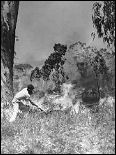
However with the increasing population of Macclesfield it was evident that better protection was required and t was not until 1939 that an organisation was formed to cover the contingency of a major outbreak of fire.
1939-1956
On Tuesday the tenth of January, 1939. South Australia was in the grip of a heatwave. This day was the fifth day of searing heat and was to herald the day of the greatest disaster in the history of Macclesfield.
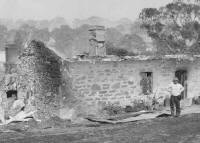
Tom Ross, infront of his house - photographer, Henry Krischock
At six-thirty in the morning a small fire broke out in the Greenhill's area. Fanned by strong north winds, the fire soon threatened the small village of Macclesfield. Efforts to fight the fire were ineffectual without proper equipment. Every family within Macclesfield area was affected by the disaster. Practically every shed and haystack was destroyed along with several houses and the brewery.
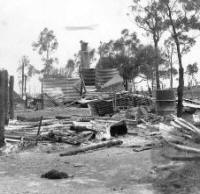
Remains of Mr Holder's house in Macclesfield - photographer, Henry Krischock
By mid-afternoon there were sixty trucks on the scene and all available local people were fighting the blaze. The fire was finally halted in the open country near Strathalbyn.
Three days later a fresh outbreak began this time toward the Bugle Ranges. Several houses were destroyed along with many head of sheep and cattle. Volunteers came by train from Adelaide to fight the fires. The total area destroyed was just over one hundred square miles.
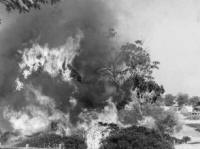
Bush fire approaching the township of Macclesfield - photographer, Henry Krischock
It was because of the disaster which had threatened Macclesfield than an organisation came into being to assist in the fighting of fires within the Macclesfield area. This organisation was known as "The Macclesfield District Volunteer Fire Fighting Organisation". The organisation was provided with a pump and a tank by the then Meadows Council. The equipment provided was able to be piggy-backed onto privately owned vehicles (predominantly the trucks from the local cheese factory were used).
During 1941 a small fire broke out and threatened one of the churches in the Macclesfield area. The church was able to be saved but the local community was concerned at the lack of effective fire fighting equipment in the district. However before any definite plans could be made concerning new fire fighting equipment all efforts were hampered because of the Second World War.
In 1955 there was again a fire in the area equal to the devastation of 1939. The fire began on the corner of Shoebrooks Road approximately three kilometres north of Macclesfield. The fire was thought to be caused by a pile of rubbish left burning by ETSA. This fire was fanned by high winds and raced across the country side taking only ten minutes to reach Cosgrove Road, approximately five kilometres south of Macclesfield.
Once again many head of cattle were destroyed along with several homes. The fire was halted at a farm property (Haig's farm) on the outskirts of the Strathalbyn township.
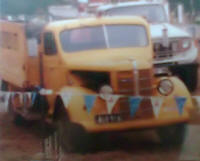
This fire resulted in a special fire truck appeal being held in 1956 by the locals to raise money to purchase a fire truck. The truck was a second-hand 1954 Bedford. After the purchase of the fire truck, the Macclesfield fire fighting organisation was fully formed and joined the South Australian Emergency Fire Service (EFS).

Several local people were instrumental in forming this organisation and without the efforts of RW.Tonkin, WW.White, L.Pullen and the support of the local community the organisation may have floundered and not been brought in to being for a good deal longer.
1956-1977
It was shortly after (in 1958), the purchase of the fire truck, that a shed was built to house the Bedford. The fire truck proved itself to be a very useful and attend numerous fires each year, predominantly haystacks and some burn-offs which had gone out of control.
A few years after purchasing the Bedford, the community were concerned that one truck was not adequate protection for the town's requirements. Should an outbreak occur outside the town's precincts and the Bedford was dispatched to help to contain the blaze the town was left unprotected. The decision was made, after several meetings, that a second-hand Ford Blitz be purchased from ETSA. The price of the second truck was £200 and was purchased in 1961.
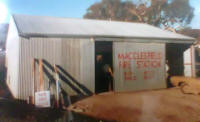
With the purchase of the second vehicle and an increasing amount of equipment acquired over the years it was found that the shed the organisation was using was not large enough and so in 1964 a new shed was erected on the corner opposite Davenport Square, the site of the station today.
The money required for the truck and shed was achieved in fundraising activities and was also partly subsidised by the Meadows Council. In 1965 at a meeting held on 7th September a further decision was made to purchase a small Land Rover Vehicle or similar. This vehicle was to act as a quick attack/command vehicle.
The vehicle which was purchased was a 1954 Dodge utility. This vehicle proved to be a handy addition to the Brigade and was also involved in assisting in the containment of many small fires in and around the district. As time went on the Brigade was gradually achieving better improvements with newer and better equipment.
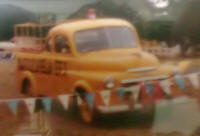
The greatest improvement was to occur in the communications area when the FACU telephone system was introduced in 1975. This system, *no longer in service today*, allowed several people to answer an emergency call and sound the siren from a private telephone instead of going to the shed to activate the siren. The result of this was a quicker response (the average time for a truck to mobile after a call is three minutes)
The radio communications have also improved considerably over the years.
1977-1983
In 1977 another noticeable change occurred. This time it was the name of the organisation which changed from the Emergency Fire Service (EFS) to the Country Fire Service (CFS). This had no impact on the way the Brigade was run and the organisation continued to function as before.

During the latter part of 1977 as a result of a Council meeting, the Brigade would in all probability receive one of three new fire trucks purchased by the Council. The Brigade did in fact receive a new truck as a result of this meeting a new International D1610 was commissioned and given the callsign of Macclesfield 43. The International was to replace the Ford Blitz which was subject to frequent breakdowns and was becoming a very unreliable vehicle.
The International - Macclesfield 43 - was to become the Macclesfield CFS's main attack vehicle.
Not long after the commissioning of the new vehicle it received its trial by fire literally in the form on one of this states worst wild fires, Ash Wednesday. The fire started in the Heathfield Rubbish dump and burnt out many towns in the Adelaide Hills. Eventually the fire was contained outside Echunga. Crews from Macclesfield and surrounding districts spend several days mopping up afterwards.
Two years after Ash Wednesday another large fire broke out near Wistow. All of the brigades in the surrounding area were called to fight this fire. Macclesfield was the nearest to the fire, however, the actual township was never threatened by this fire. Several houses were destroyed along with a couple of haystacks and many head of stock. It was later found that the cause of this fire was sparks from a passing goods train.
1983-1988
On 16th February 1983, the anniversary of Ash Wednesday, another heatwave was being experienced by South Australia and again another bushfire started. This fire was to prove to be more devastating than Ash Wednesday and was christened by the fire-fighters, Ash Wednesday II. There were numerous outbreaks on this day adding to the confusion of the whole day.
The Macclesfield Brigade was to help fight the fire in the Kuitpo State Forest Area. At one stage the fire was a threat to Macclesfield township and the majority of the community was evacuated to the oval. Fortunately there was a major wind change and the fire stopped short of the town. Fire crews spent the next fortnight putting out hot spots.
It was decided after this recent spate of fires that the old Bedford was outdated and was not up to the standard required by the Macclesfield Brigade. The decision was made to purchase a new truck. The truck which was decided upon was an International 610A and was nominated Macclesfield 42. The truck was taken into Meadows soon after it was bought to be built by Mr R Hay and was later brought into service.
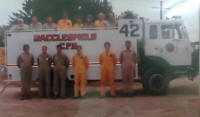
In 1983 the most significant change to the Macclesfield CFS was to occur. During the year the Meadows Council decreased its area and put Macclesfield and Meadows outside the Meadows Council area. Macclesfield became part of the Mount Barker Council area. As a result of this reorganisation of boundaries the community joined the Mount Barker Group, which is made up of nine brigades within this council area.
The major difference as a result of this reorganisation was an increase in funding. The increased funding meant an upgrade and renewal of equipment. Training levels also improved greatly and more exercises were able to be undertaken involving other brigades. The Mount Barker Group (Group) also ensure that better brigade training occurred. Attendance and interest within the community increased as a result.
It was not until 1984 that the build up on 42 had been completed and was ready for action.
Later in the year it was decided that our brigade should be further equip with Breathing Apparatus. This would ensure that fire-fighters would not be exposed to toxic fumes when fighting fires. Fire-fighters using this equipment are required to participate in special training courses. The acquisition of this piece of equipment meant that the role of the Brigade could be diversified. Some of the incidents which the Brigade could expect to face could involve chemical spills and rescue operations. However, this was not expected to be a major role of the Brigade.
Towards the end of 1984 it was proposed that we buy a new small attack vehicle to replace to ageing Dodge. The proposal was approved by the Macclesfield Brigade Committee and shortly afterwards a Toyota Land Cruiser was purchased.
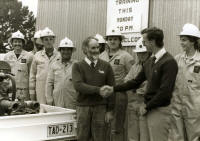
The decision was made to fit out the new Toyota with only the necessary equipment and leave the major refit until after the fire season. This proved to be a very wise decision as during the worst part of the fire season, February 1985, a large fire broke out at Wistow. The fire burnt out many acres of land but fortunately no houses were destroyed. The Toyota was used extensively at the fire and was very useful. The unit's refit was later completed by the TAFE College of Adelaide.
Later in 1985 the fire shed was upgraded and improved. It was extended to almost double its size. A separate communications area was built as were meeting rooms and a kitchen. The project took several weeks to complete and most of the work was completed by volunteers from within the Macclesfield community.
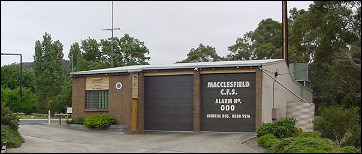
The following years were relatively quiet as far as fire fighting were concerned and this enabled the Macclesfield Brigade to complete work on Unit 43. A new build-up was completed and a trailer pump was completed by cadet fire-fighters. The trailer pump was designed to be used at large fires and could be used to fill up trucks from a dam or creek.
1988
In January 1988 the Brigade for the first time in its brief history was sent on a task force to Melrose in the Flinders Ranges to relieve fire-fighters in the area. A large fire was burning out of control in the Mount Remarkable National Park and a fire crew was sent in the upgraded Unit 43.
In 1988 there were cutbacks in the CFS funding and many vehicles were sold including Unit 43. However, the Brigade was able to fund the purchase of this unit and now maintain this as a Brigade owned vehicle. The Macclesfield Brigade believed it to be necessary to purchase and maintain this vehicle in order to retain the high fire fighting capacity and efficiency built up over the years.
1988-1984
Between 1988 and 1994 there have not been any major outbreaks of fire within the area of the Adelaide Hills.
The old International D1610 was sold for scrap as the vehicle was old and not useable.
The Brigade was now down to one unit and this severely affected the Brigades strength.
During January 1994 New South Wales experienced its worst fires ever and task forces were sent to Sydney to assist on 6th and 7th of January. The result of this was that 9 firefighters from the Macclesfield area were sent to assist.
1994-1995
The Toyota was becoming outdated and a decision was made to replace this with a Kia four wheel drive. Although this vehicle has been purchased the build up on this vehicle will prove to be a costly exercise and the Brigade will again be required to approach the Macclesfield community to outfit this vehicle.
On a positive note the Cadet Group of the Macclesfield Brigade has been reformed and a new group of upcoming young fire-fighters is being trained to meet any emergency the Macclesfield community area may face in the future.
This information has been sourced from the Brigade website at this address
Brigade Stations
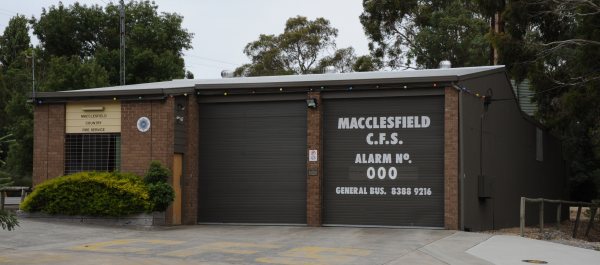
1964 to Present - Parin Street, Macclesfield
Photographer, CFS Promotions Unit - Mar 2012
Google Map reference - Longitude 138.836960 Latitude -35.171030
Captains
Life Members
SACFS Promotions Unit
http://www.fire-brigade.asn.au